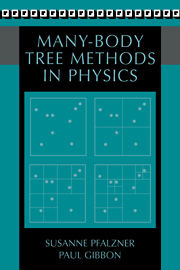Book contents
- Frontmatter
- Contents
- Preface
- Errata
- 1 Introduction
- 2 Basic Principles of the Hierarchical Tree Method
- 3 Open Boundary Problems
- 4 Optimisation of Hierarchical Tree Codes
- 5 Periodic Boundary Conditions
- 6 Periodic Boundary Problems
- 7 The Fast Multipole Method
- Appendix 1 Multipole Expansion in Two Dimensions
- Appendix 2 Spherical Harmonics
- Appendix 3 Near-Neighbour Search
- Refrences
- Index
6 - Periodic Boundary Problems
Published online by Cambridge University Press: 11 September 2009
- Frontmatter
- Contents
- Preface
- Errata
- 1 Introduction
- 2 Basic Principles of the Hierarchical Tree Method
- 3 Open Boundary Problems
- 4 Optimisation of Hierarchical Tree Codes
- 5 Periodic Boundary Conditions
- 6 Periodic Boundary Problems
- 7 The Fast Multipole Method
- Appendix 1 Multipole Expansion in Two Dimensions
- Appendix 2 Spherical Harmonics
- Appendix 3 Near-Neighbour Search
- Refrences
- Index
Summary
In this chapter we will consider a variety of fields where the tree algorithm in combination with periodic boundaries can be applied and where the speedup in comparison to standard MD and MC codes enables previously inaccessible problems to be investigated. This set of applications is in no way exhaustive, but is intended to indicate the types of problems where the algorithm might best be put to use.
Practically every N-body MD or MC code could incorporate the tree algorithm. However, for systems with short-range potentials, like the Lennard–Jones potentials for the description of solids, this does not bring much of an advantage. Because the potential falls off very rapidly (see Fig. 6.1), a sharp cutoff can be used to exclude interactions of more distant particles whose contribution is negligible. The tree algorithm is mainly suited to systems with long-range forces such as Coulomb, where the summed effect of distant particles is important.
An ideal application is dense, fully-ionized plasmas. Here the particles are so closely packed that an analytical treatment is difficult, and many MD and MC calculations have been carried out to investigate their properties. Limitations in the number of simulation particles make some problems difficult to address due to a combination of poor statistics and small system size. The tree algorithm could be successfully applied here, because the particles interact purely through Coulomb forces.
- Type
- Chapter
- Information
- Many-Body Tree Methods in Physics , pp. 109 - 125Publisher: Cambridge University PressPrint publication year: 1996

